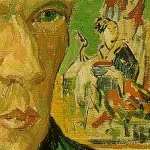
If you're a regular reader of this blog you know that I recently attended the 2010 AWP conference in Denver, and at the amazing AWP book fair I purchased a book called Absinthe, Sip of Seduction: A Contemporary Guide. It's really turned out to be a wonderful resource as I try to find out more about this infamously favorite drink (nicknamed "The Green Fairy") of the Impressionist and Neo-Impressionist painters living in 19th century Paris. If nothing else, the book has shown me how silly I was to just drink absinthe straight up, as I did the first time. (See my earlier post about that experiment.) Not only is that not the traditional or typical way to imbibe absinthe, but it's strongly cautioned against by the authors of this book. To quote: "drinking absinthe neat can result in gratuitous tears and choking due to the intense and bitter taste." (Yes, indeed.)
The book has also provided much useful information about the supposed connection between absinthe and madness, a connection made all the more popular given the particular form of "madness" that infected Van Gogh starting in December, 1888. Some commentators have tried to claim that it was absinthe that undid Van Gogh, but--as Sip of Seduction points out--this is a difficult case to make, because we can't be sure whether or not Van Gogh drank much absinthe at all. It certainly was the favorite drink among many artists and writers living in Paris in the late 1800s, and it was certainly a favorite of Paul Gauguin, who eventually became one of the most important people in Van Gogh's life. But no one knows how much of the stuff Van Gogh actually drank. It comes up hardly at all in his letters, but then again Van Gogh wrote comparatively few letters during his time in Paris (because the man he wrote most of his letters to was now his housemate). When he left Paris, he did claim that his health was poor and that if he had stayed he might have become an alcoholic. But he did not attest to any special attraction to absinthe. Most people who have looked into Van Gogh's condition (apparently a rare form of epilepsy) claim multiple contributing factors: poor eating habits, years of working himself to the point of exhaustion, a series of emotional crises, a diet consisting mainly of coffee and pipe tobacco, the unavoidable inhalation of fumes from paints and thinners, and--most particularly--a family history of mental illness.
That said, some very interesting facts appear in Sip of Seduction. Apparently, the psychoactive power of wormwood (absinthe's key ingredient) has been greatly exaggerated to the point of mythology, but during the heyday of absinthe's popularity, some manufacturers of inferior quality product added poisonous colorants to artificially bring about the famous glowing green shade of the real thing. According to the book: "commonly used harmful adulterants included copper salts, aniline dye, and turmeric . . . These cheap, toxic absinthes were common fare among those of lower socioeconomic status in urban areas." I think it's safe to say that struggling painters can be counted among the lower socioeconomic classes. Also intriguing is that, even before Van Gogh had a reputation of any kind at all, it was noticed that certain drinkers of absinthe demonstrated odd behaviors: "erratic mood shifts, disconcerting tic disorders, and in some cases blindness." As public opinion turned against the spirit, it began to be blamed for a whole range of symptoms: "convulsions . . . sleeplessness, tremors, and hallucinations." Even epilepsy! Whether absinthe abuse (as opposed to alcohol addiction generally) was uniquely responsible for such behaviors and conditions, it's certainly is true that hallucinations, erratic mood shifts, tremors, and convulsions were demonstrated by Van Gogh during his attacks.
So am I saying absinthe really was the culprit in Van Gogh's case? No, not at all. He had so much stacked against him to begin with--something I try to emphasize in my novel--that he did not need an alcoholic spirit to push him over the edge. He went there, I'm pretty well sure, all on his own.













0 comments:
Post a Comment